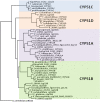CYP51 Paralogue Structure Is Associated with Intrinsic Azole Resistance in Fungi
- PMID: 34607450
- PMCID: PMC8546618
- DOI: 10.1128/mBio.01945-21
CYP51 Paralogue Structure Is Associated with Intrinsic Azole Resistance in Fungi
Abstract
Azoles are the most commonly used clinical antifungal therapy and also play an important role in control of plant pathogens. Intrinsic resistance to the azole class of fungicides, which target lanosterol demethylase (CYP51), is observed in many fungal species; however, the mechanisms underpinning this phenomenon are unknown. In this study, 5 azole-resistant Penicillium isolates from patients attending the UK National Aspergillosis Centre that could not be morphologically identified to species level were analyzed by genome sequencing. The genomes and CYP51 paralogue structure from these isolates were compared with those of 46 representative fungal isolates to identify to species level and examine possible mechanisms of drug resistance. Analysis of CYP51 paralogues showed that azole-resistant isolates from this study (n = 2) and from public databases (n = 6) contained a new CYP51 paralogue, CYP51D, which was associated with azole resistance in 6/8 cases and never occurred in azole-sensitive species (46/46 tested). Furthermore, one isolate from this study and an azole-resistant Aspergillus fumigatiaffinis isolate were shown to encode a CYP51A paralogue, CYP51A2. Introduction of CYP51A2 to the closely related but azole-sensitive Aspergillus fumigatus resulted in azole resistance. The identification of novel CYP51A and CYP51D paralogues in resistant fungi and the observation that resistance to azoles can be conferred by introducing a CYP51A paralogue from a resistant species into an azole-sensitive species are a potentially important new azole resistance mechanism. IMPORTANCE Azole antifungals are the main treatment for fungal disease in humans. Many species are intrinsically resistant to azoles-in other words all members of the species are resistant without prior exposure-and we do not understand why. In this study, we serendipitously discovered that many intrinsically resistant species have alternative or extra copies of the azole target gene, CYP51. Transfer of one of these genes from a resistant species to a sensitive one resulted in drug resistance, showing that the extra copies of CYP51 can confer drug resistance. Understanding how clinically important species are resistant to therapy allows us to predict whether a species could be resistant from genome sequence.
Keywords: Aspergillus; CYP51; Penicillium; antifungal agents; antifungal resistance; cryptic; paralogy.
Figures


Similar articles
-
Does agricultural use of azole fungicides contribute to resistance in the human pathogen Aspergillus fumigatus?Pest Manag Sci. 2017 Oct;73(10):1987-1993. doi: 10.1002/ps.4607. Epub 2017 Jul 24. Pest Manag Sci. 2017. PMID: 28485100
-
High detection rate of azole-resistant Aspergillus fumigatus after treatment with azole antifungal drugs among patients with chronic pulmonary aspergillosis in a single hospital setting with low azole resistance.Med Mycol. 2021 Apr 6;59(4):327-334. doi: 10.1093/mmy/myaa052. Med Mycol. 2021. PMID: 32642756
-
Trends in the activity of mold-active azole agents against Aspergillus fumigatus clinical isolates with and without cyp51 alterations from Europe and North America (2017-2021).J Clin Microbiol. 2024 Feb 14;62(2):e0114123. doi: 10.1128/jcm.01141-23. Epub 2024 Jan 9. J Clin Microbiol. 2024. PMID: 38193696 Free PMC article.
-
Exploring the molecular mechanism of azole resistance in Aspergillus fumigatus.J Mycol Med. 2020 Apr;30(1):100915. doi: 10.1016/j.mycmed.2019.100915. Epub 2019 Dec 6. J Mycol Med. 2020. PMID: 32008963 Review.
-
Resistance in human pathogenic yeasts and filamentous fungi: prevalence, underlying molecular mechanisms and link to the use of antifungals in humans and the environment.Dan Med J. 2016 Oct;63(10):B5288. Dan Med J. 2016. PMID: 27697142 Review.
Cited by
-
Metabolomics analysis of the effect of acidification on rhizosphere soil microecosystem of tea tree.Front Plant Sci. 2023 Feb 24;14:1137465. doi: 10.3389/fpls.2023.1137465. eCollection 2023. Front Plant Sci. 2023. PMID: 36909384 Free PMC article.
-
The Transcription Factor CsAtf1 Negatively Regulates the Cytochrome P450 Gene CsCyp51G1 to Increase Fludioxonil Sensitivity in Colletotrichum siamense.J Fungi (Basel). 2022 Sep 29;8(10):1032. doi: 10.3390/jof8101032. J Fungi (Basel). 2022. PMID: 36294597 Free PMC article.
-
The challenges of the genome-based identification of antifungal resistance in the clinical routine.Front Microbiol. 2023 Apr 20;14:1134755. doi: 10.3389/fmicb.2023.1134755. eCollection 2023. Front Microbiol. 2023. PMID: 37152754 Free PMC article.
-
Exploring SARS-CoV2 host-pathogen interactions and associated fungal infections cross-talk: Screening of targets and understanding pathogenesis.Comput Struct Biotechnol J. 2022;20:4351-4359. doi: 10.1016/j.csbj.2022.08.013. Epub 2022 Aug 10. Comput Struct Biotechnol J. 2022. PMID: 35965662 Free PMC article.
-
Azole Resistance and cyp51A Mutation of Aspergillus fumigatus in a Tertiary Referral Hospital in Taiwan.J Fungi (Basel). 2022 Aug 26;8(9):908. doi: 10.3390/jof8090908. J Fungi (Basel). 2022. PMID: 36135633 Free PMC article.
References
-
- Furukawa T, van Rhijn N, Fraczek M, Gsaller F, Davies E, Carr P, Gago S, Fortune-Grant R, Rahman S, Gilsenan JM, Houlder E, Kowalski CH, Raj S, Paul S, Cook P, Parker JE, Kelly S, Cramer RA, Latgé J-P, Moye-Rowley S, Bignell E, Bowyer P, Bromley MJ. 2020. The negative cofactor 2 complex is a key regulator of drug resistance in Aspergillus fumigatus. Nat Commun 11:427. doi:10.1038/s41467-019-14191-1. - DOI - PMC - PubMed
Publication types
MeSH terms
Substances
Supplementary concepts
Grants and funding
LinkOut - more resources
Full Text Sources
Medical

